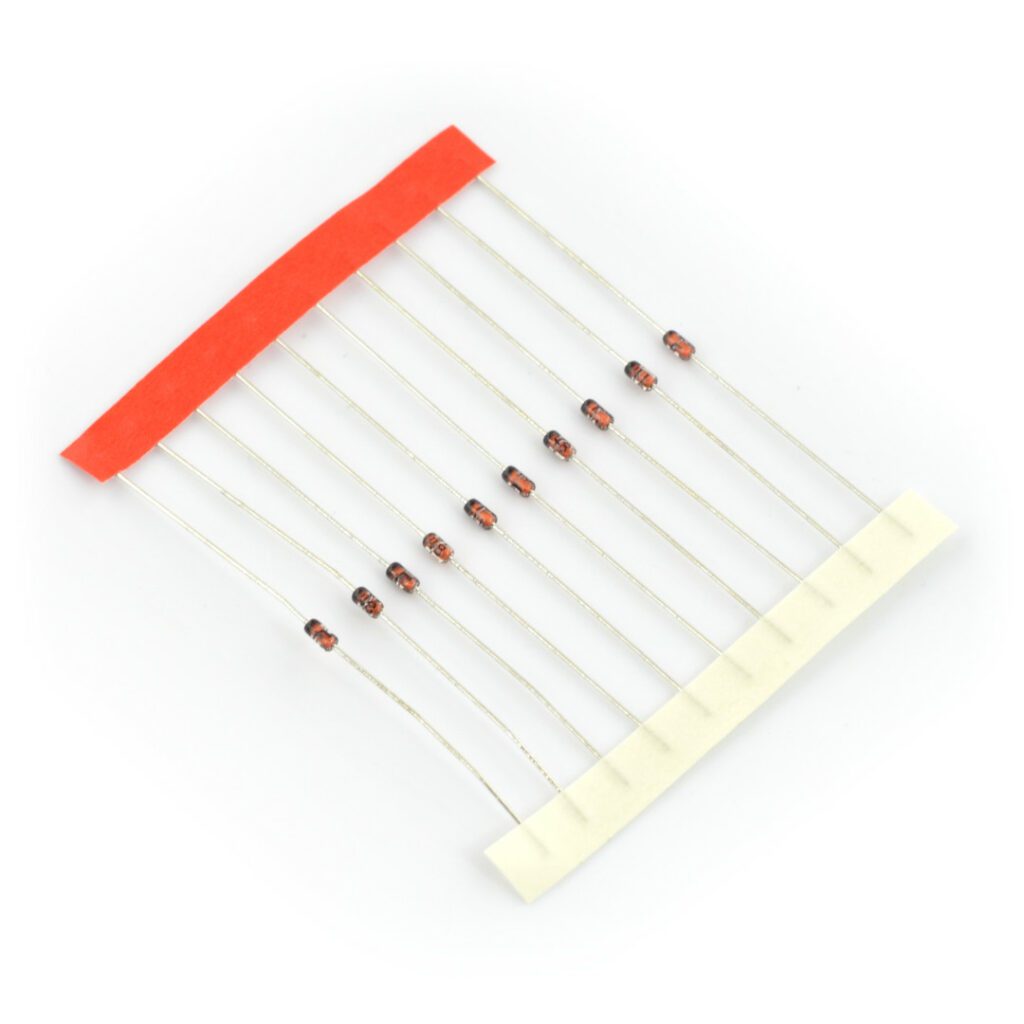Table of Contents:
Rectifier diodes are a type of semiconductor diodes that mostly allow electric current to flow in one direction only. In other words, they allow current conduction only if the anode – often the side usually marked as a dash on the diode’s housing – is positively polarized with respect to the cathode, the side usually marked as either a triangle or a blank without a dash.
These diodes are used – as the name suggests, by the way – mainly in rectifier circuits. The term “bestseller” should perhaps be used primarily in the context of sales products in the retail market and not necessarily in the electronic components market, but the 1N418 diodes are by far one of Botland‘s most popular items. It is produced all over the world, not tied to a specific manufacturer and appeared on the market many decades ago. Let’s see if there is more behind the popularity of the 1N4148 than its low price.
Technical data 1N4148, thermal characteristics
1N4148 as a standard silicon rectifying diode is used to convert alternating current (AC) to direct current (DC). Alternating current is generally supplied by the power grid, but some devices need direct current to operate properly. Therefore, it is necessary to convert – otherwise known as rectification – alternating current to direct current. It is useful for applications up to 100 MHz with lightning-fast recovery times. Thus, it is known for its fast-switching properties.
This diode is used in the gate circuit of transistors, MOSFETs and bipolar transistors with an isolated gate in order to quickly transfer the signal from the integrated circuit.Interestingly, there is a fairly common misconception that 1N4148 is a Zener diode. While the Zener diode conducts in both directions, the 1N4148 conducts only in the forward polarity state.
A sound understanding of the 1N4148 datasheets and application notes is essential when exploiting its potential advantages in older circuit designs.
- Maximum voltage: 100 V
- Maximum current: 150 mA
- Chassis: DO-35, THT through-hole
The 1N4148 diodes can safely handle a maximum voltage spike of 100 V in the reverse direction. The maximum voltage drop in the reverse-polarized state should not exceed 75 V. When the diode is forward polarized, it can conduct up to 300 mA with a peak value of no more than 500 mA continuously. However, under extreme conditions, it can safely handle a maximum peak current of 2 A for no more than 1 μs. In terms of thermal characteristics, and therefore preventing overheating and diode failure, the 1N4148 can dissipate 75°C of heat from the die surface to the surrounding air through all paths when it consumes 1 W of power. The diode operates safely when the temperature of the connector does not exceed 175°C.
Electrical characteristics of the 1N4148
The diode starts conducting when a minimum forward-polarized junction voltage of 0.7 V is applied. However, in the forward-polarized state, the maximum voltage drop across the diode would be 1 V to pass the rated current through it. The 1N4148 datasheet also gives the maximum current that can flow through the diode in the reverse (IR) direction under various test conditions. The diode enters the breakdown zone when a voltage of 100 volts is applied to the terminals in the reverse direction, also known as the breakdown voltage. Once punctured, the current flow through the diode increases exponentially and leads to damage.
For any diode, there is some unwanted capacitance (CD) due to the presence of charge particles at the p-n junction and depleted layer. In the case of the 1N4148, this intrinsic capacitance has a maximum value of 4pF. This is worth considering as a design parameter for high-frequency circuits such as amplifiers and resonators. The recovery time for general diodes is usually 150-200ns, and for ultrafast diodes about 20ns. However, in the case of the 1N4148, it takes only 8ns. In the 1N4148 specification, ideal conditions can be found to reduce this time even to 4ns. This is the reason why this diode is in high demand for high-speed switching applications.
Typical applications of the 1N4148 rectifying diode
- rectifiers
- power supplies
- signal detectors and amplifiers
- oscillating systems
- signal converters
- logic
- synchronization systems
- battery chargers
Rectifier diode 1N4148 - reviews, price
The 1N4148 diode is a reliable semiconductor that engineers and circuit designers have relied on for years. It remains generally available and relatively inexpensive, making it a popular choice for many electronic projects. The price of a set of 10 pieces in Botland does not exceed 1 zloty. It is widely used in applications ranging from rectifiers to signal detection systems. It has a relatively low power loss during conduction, which is important in the efficient use of electricity in electronic circuits. It is regarded as a diode that is stable under various operating conditions, making it easy to use and does not require special operating conditions, durable and rarely replaced for reasons of failure. And since it is widely used, it is not difficult to find documentation, tutorials and specific projects using it. Undoubtedly, however, the 1N4148’s greatest asset is its short switching time, making it unmatched in tasks such as high-frequency signal detection. Limitations include low transmission current, low conduction voltage and slightly lower switching speed compared to Schottky diodes. However, it is hard to find a better choice at this price.
How useful was this post?
Click on a star to rate it!
Average rating 4.9 / 5. Vote count: 8
No votes so far! Be the first to rate this post.




















